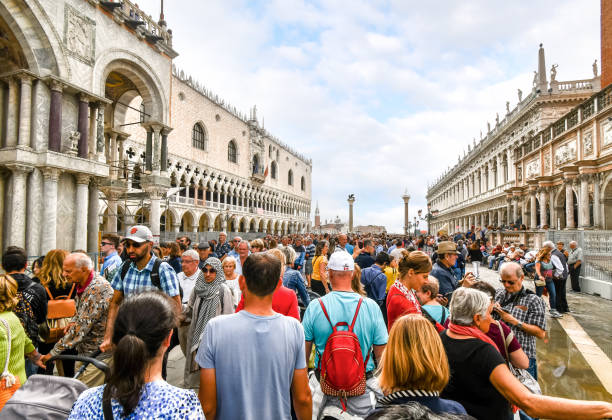In recent years, the global travel landscape has shifted dramatically. While some destinations have long been considered the pinnacle of wanderlust—think Venice, Bali, and Barcelona—many are now grappling with the negative impacts of overtourism. Overcrowded streets, environmental degradation, rising costs, and a loss of local culture are just some of the consequences of mass tourism. As travelers become more aware of these issues, there’s a growing desire to explore undiscovered destinations—places that offer similar experiences but with fewer crowds and a more sustainable approach to tourism.
In this post, we’ll compare the rise of overtourism with the emerging trend of searching for hidden gems, offering practical suggestions for sustainable alternatives to popular hotspots. Let’s dive into how travelers can contribute to responsible tourism while still enjoying incredible experiences.
The Rise of Overtourism: A Growing Problem
Overtourism refers to the phenomenon where a destination becomes so popular that it can no longer cope with the number of visitors. Popular spots like Venice, Barcelona, and Bali have faced significant pressure in recent years. In Venice, residents have been displaced by the influx of cruise ship tourists, while in Bali, environmental degradation has increased due to unregulated mass tourism. In Barcelona, authorities have had to implement measures to limit the number of tourists visiting key attractions like La Sagrada Familia and Park Güell, as overcrowding has taken a toll on the city’s infrastructure and local life.
Here are some common issues caused by overtourism:
- Environmental Damage: Overcrowding leads to increased waste, pollution, and wear-and-tear on natural landscapes.
- Cultural Erosion: Mass tourism can dilute the authenticity of local traditions, and in some cases, it may even lead to the commodification of culture.
- Economic Inequality: While tourism can bring in revenue, it can also inflate prices for locals and make it difficult for residents to afford to live in their own neighborhoods.
- Decreased Quality of Experience: Visitors seeking the “Instagram-perfect” shot often find themselves shoulder-to-shoulder with thousands of others, diminishing the sense of tranquility and the unique appeal of the destination.
The solution? Travelers are increasingly turning their attention to lesser-known destinations that allow for more intimate, meaningful experiences and contribute to sustainable tourism practices.
Undiscovered Destinations: The Allure of Hidden Gems
While popular destinations are often well-publicized, there are countless hidden gems around the world that offer similar experiences without the chaos of overtourism. These lesser-known spots provide an opportunity to enjoy authentic experiences while preserving the local culture and environment. By exploring these destinations, travelers can play a role in relieving the pressure on crowded hotspots, ensuring that tourism remains sustainable for years to come.
Here’s a look at some undiscovered destinations that serve as excellent alternatives to the overcrowded classics:
1. Overtourism: Venice, Italy
Undiscovered Alternative: Trieste, Italy
- Why Trieste? Trieste, located in northeastern Italy, offers the same Venetian charm but without the crowds. This elegant port city boasts a rich history, stunning architecture, and beautiful Adriatic coastlines. Visit the Piazza Unità d’Italia, wander the picturesque streets, and enjoy the café culture that rivals Venice without the throngs of tourists.
- Sustainable Tip: Trieste is less reliant on mass tourism and has more local businesses, giving travelers a chance to support the community. By visiting Trieste, you’ll help reduce the strain on Venice’s fragile ecosystem.
2. Overtourism: Bali, Indonesia
Undiscovered Alternative: Sumatra, Indonesia
- Why Sumatra? Bali’s popularity has led to overdevelopment, leaving parts of the island struggling with waste and environmental damage. For a more tranquil and eco-conscious experience, head to Sumatra. This Indonesian island offers incredible biodiversity, including the Taman Nasional Gunung Leuser rainforests, home to endangered orangutans, and the stunning Lake Toba. Sumatra remains relatively untapped by mass tourism, allowing visitors to explore unspoiled nature and cultural traditions.
- Sustainable Tip: Sumatra offers opportunities to engage in eco-tourism initiatives, such as wildlife conservation efforts and community-based tourism, which help preserve its natural and cultural heritage.
3. Overtourism: Barcelona, Spain
Undiscovered Alternative: Girona, Spain
- Why Girona? While Barcelona has long been a top destination for culture, architecture, and food, it’s also one of the most visited cities in Europe, leading to overcrowded attractions and inflated prices. Girona, just 40 minutes north, is a medieval gem that offers a similar Catalan vibe with far fewer tourists. Walk along the winding streets of the Jewish Quarter, explore the medieval Girona Cathedral, or visit the famous Arab Baths. With its rich history and stunning architecture, Girona provides an authentic and peaceful alternative to Barcelona.
- Sustainable Tip: By choosing Girona, you’re helping alleviate the pressure on Barcelona’s infrastructure while also supporting smaller local businesses in a town that is deeply rooted in its traditions.
4. Overtourism: Santorini, Greece
Undiscovered Alternative: Naxos, Greece
- Why Naxos? While Santorini is famous for its whitewashed buildings, crystal-clear waters, and breathtaking sunsets, its popularity has led to overdevelopment, overcrowded streets, and environmental strain. Naxos, the largest island in the Cyclades, offers a more authentic Greek island experience with stunning beaches, charming villages, and ancient ruins. Visit the Temple of Apollo or explore the Old Town, all while enjoying a quieter atmosphere and the warm hospitality of the locals.
- Sustainable Tip: Naxos has taken steps toward sustainable tourism, promoting eco-friendly accommodations and activities such as organic farming and sustainable fishing.
5. Overtourism: Kyoto, Japan
Undiscovered Alternative: Kanazawa, Japan
- Why Kanazawa? Kyoto is a city of incredible cultural and historical significance, but its popularity can lead to overwhelming crowds, particularly at famous temples like Kinkaku-ji and Fushimi Inari-taisha. Instead, head to Kanazawa, a city that offers a similar cultural richness with far fewer tourists. Known for its well-preserved samurai and geisha districts, as well as its beautiful gardens like Kenroku-en, Kanazawa offers a peaceful experience immersed in tradition.
- Sustainable Tip: Kanazawa’s more manageable tourism numbers help maintain its authenticity, and visitors can support the local economy by staying in traditional ryokan inns and exploring family-owned craft shops.
How to Find Hidden Gems and Travel Responsibly
Finding these lesser-known destinations is just the beginning. Once you’ve decided on a hidden gem, the next step is ensuring that your visit contributes to the local community without causing harm. Here are some sustainable travel tips to keep in mind:
- Support Local Businesses: Choose locally-owned hotels, restaurants, and shops. These businesses often have a smaller environmental footprint and help support the local economy.
- Travel During Off-Peak Seasons: Avoid traveling during peak times to help reduce the strain on infrastructure and the environment. The off-season often offers a more peaceful experience, with fewer crowds and lower prices.
- Respect Local Culture: Be mindful of the customs and traditions of the places you visit. Learn a bit about the local history and culture before you go, and be respectful of local practices.
- Leave No Trace: Whether you’re trekking through mountains or relaxing on a beach, make sure to leave nature as you found it. Always clean up after yourself and dispose of waste properly.
- Choose Eco-Friendly Accommodations: Many small hotels and lodges in hidden gems are committed to sustainability. Look for accommodations that use renewable energy, practice waste reduction, and promote eco-friendly tourism.
The Future of Travel is About Balance
The rise of overtourism has highlighted the need for a shift in how we approach travel. While iconic destinations will always have their place, the future of tourism lies in the discovery of lesser-known, off-the-beaten-path destinations. By choosing undiscovered gems, travelers can enjoy the same breathtaking beauty, cultural richness, and immersive experiences—without the negative impacts of mass tourism. At the same time, they contribute to sustainable tourism practices that help preserve these places for future generations.
In 2024, let’s embrace the opportunity to explore new horizons, visit hidden gems, and support responsible travel. The world is full of incredible places waiting to be discovered—it’s up to us to find them, explore them thoughtfully, and leave them better than we found them.




